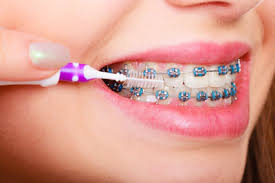How Braces Straighten Children and Adult Teeth

How Braces Straighten Children and Adult Teeth
What Are Braces?
Braces are orthodontic dental devices designed to correct misalignments of the teeth and jaws. These “miniature heroes” are key to achieving a confident, healthy smile. But how exactly do braces work to straighten your teeth?
Imagine your teeth as pieces of a puzzle that don’t fit together properly. This misalignment could result from genetic factors, habits like thumb-sucking, or even an accident. Misaligned teeth can cause pain during chewing, speech difficulties, or self-consciousness about your smile. This is where braces come to the rescue.
There are two main types of braces: traditional braces and clear aligners. While traditional braces use visible metal components, clear aligners, like Invisalign aligners, are less noticeable due to their ceramic or frosted wires that blend with the natural color of your teeth.
Braces have three primary components: brackets, bands, and archwires. Brackets are small, square units bonded to the teeth, while bands secure these brackets in place. The archwire runs through the brackets, exerting gentle pressure to guide your teeth into alignment.
What Is the Difference Between Adult and Children’s Braces?
Braces for children and adults differ in several ways:
- Treatment Time:
- Children: 18–36 months
- Adults: 2–3 years
- Cost: Braces tend to be less expensive for children because their cases often require fewer materials.
- Appearance: Adults may prefer less noticeable options, such as ceramic braces or clear aligners like Invisalign.
- Bone Structure: Adults have fully developed teeth and jawbones, making it harder to move teeth into new positions. This sometimes limits the scope of treatment compared to children.
- Pain: Adults may experience slightly more discomfort during treatment due to denser bone tissue.
- Orthodontist Visits: Adults might need more frequent visits to ensure progress since teeth move differently in fully developed jaws.
Types of Braces
Orthodontic treatments come in a variety of options to suit different needs and preferences:
- Metal Braces:
Traditional braces with stainless steel brackets, wires, and bands. - Ceramic Braces:
Similar to metal braces but use tooth-colored materials for less visibility. - Lingual Braces:
These braces are attached to the back of the teeth, making them nearly invisible. - Self-Ligating Braces:
Like metal braces but with a built-in system to hold the archwire, reducing the need for elastic bands. - Clear Aligners (Invisible Braces):
Custom-made, removable trays like Invisalign aligners, offering a discreet alternative to traditional braces.
How Braces Work
Braces work by exerting pressure on the teeth to move them into their desired positions. Here’s how they achieve that:
- Brackets: Bonded to each tooth and act as anchors for the wires.
- Archwire: Threads through the brackets, applying constant pressure to shift teeth.
- Ligatures (Elastic Bands): Hold the archwire in place and add extra force where needed.
- Pressure Mechanism: The braces put pressure on the periodontal membrane under the gums, creating a push-pull effect that allows teeth to move safely.
- Bone Remodeling: Braces stimulate new bone growth to support teeth in their new positions, ensuring long-term stability.
Do Braces Hurt?
Braces may cause mild discomfort, particularly after they’re first applied or adjusted. This is because the wires and brackets exert pressure to move the teeth. Common side effects include soreness, slight pain, or irritation where the braces rub against the mouth.
Tips for Managing Discomfort:
- Take over-the-counter pain relievers.
- Rinse with cold water or suck on ice cubes.
- Eat soft foods to minimize chewing discomfort.
- Use orthodontic wax to prevent irritation.
How Long Does Treatment Take?
The duration of treatment depends on the type of braces and the severity of the misalignment:
- Clear Aligners: 6–18 months
- Traditional Braces: 18–24 months
- Severe Misalignment: 24–36 months
- Six-Month Braces: Designed for minor cosmetic corrections, focusing on visible teeth.
Cost of Braces
The cost of braces depends on the type of treatment, case complexity, and the orthodontist’s expertise. Traditional braces are typically less expensive, while clear aligners like Invisalign tend to have a higher cost due to their customization and aesthetic benefits. The Invisalign cost in Mumbai can vary significantly but is often viewed as worthwhile for its discreet and removable design.
If you’re exploring braces options, consult a reputable dental clinic in Mumbai to get an accurate estimate and discuss flexible payment plans.
Conclusion
Braces are transformative tools in orthodontics, helping both children and adults achieve healthy, confident smiles. Whether you choose traditional braces or invisible braces like Invisalign, the results are worth the commitment. Consult an experienced orthodontist at an orthodontic dental clinic to determine the best treatment for your needs.
Ready to start your journey toward a perfect smile? Book your appointment with the best dentist in Mumbai today. A brighter, healthier smile is just around the corner!








